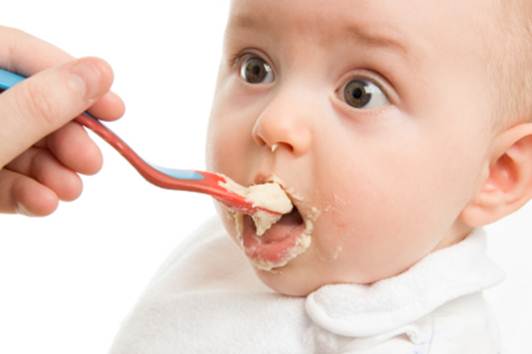Hearing listening up

In your belly
At 20 weeks, your foetus can detect a
garbles version of your voice. During the third trimester in response to the
external sounds he hears.
In the world
A newborn remembers noises form the womb,
such as your voice and song he’s heard. He can readily discriminate between
speech sounds, such as “ba” and “da”. At 3 months, your infant may attempt to
duplicate sounds by cooing, says US-based Dr. Susan H. Landry. By 5 months the
excitement of hearing his own voice and your responses may turn him into a
babbling machine. Around 8 months, he understands the meaning of many words he
hear, and as he inches toward 1, he’ll say a few (such as “dada” and “uh-oh”)
even if they aren’t perfectly articulated.
Nurture it
Make music together with toy instruments.
When you read picture books, tell your baby what he’s looking at so he
associates words with objects. At around 9 months, ask him to point out things
on the page (“Can you show me a bird?” or “Where is the lion?”). this exercise
helps build his speech skills.
Vision a clearer focus

In your belly
By the third trimester, your baby can
detect bright light inside the womb. Depending on factors such as the thickness
of your clothing, fat, and muscle, enough light may seep in during the last few
months for her to see her own hand movements, as per a research published in
Developmental Psychobiology, US.
In the world
A newborn’s vision is blurry, and she sees
things best from 10 inches away (the approximate distance to your face while
she’s nursing). High-contrast hues – black-and-white patterns, and primary
colour pairings – are fascinating to her. At 2 months, she can keep a steady
gaze on moving objects, such as a rotating mobile, says Dr. Deborah
Orel-Bixler, Professor of Clinical Optometry at the University of California,
US. Within another month she’ll begin to focus on objects up to 10 feet away.
By around 4 months, she’s developing
hand-eye coordination. Around the 6-month mark, she is mastering the idea of
depth perception – when you push her from the front of her swing, she gets that
the bigger you look, the closer you are. By her first birthday, her vision is
virtually at par with that of an adult.
Nurture it
Babies love studying the contrasts on faces
– think dark pupils against the whites of your eyes and your hairline next to
your skin. Intensify the colours by wearing bright lipstick on your face. You
can hold your baby in front of a mirror, she’ll be mesmerized by seeing her own
face and will observe the different colours she is wearing. You can strengthen
her hand-eye coordination by introducing rhythmic hand games such as “two
little hands go clap clap clap.”
Smell making scents

In your belly
During the third trimester, your baby can
detect odours from the foods you eat through your amniotic fluid, says Dr.
Eliot. Yes, he can smell your spicy fish curry.
In the world
Your newborn quickly recognizes the scents
that emanate from your breasts, your underarms, and even your beauty products,
according to a study published in Neuroscience and Biobehavioral Reviews. When
he catches a whiff of you, he might turn his head toward your breast, start
moving his mouth (as if nursing), or stop crying, says US-based Dr. Joy Browne.
Nurture it
Expose your infant to a variety of scents,
and tell him what he’s smelling, suggests Dr. Marcia Levin Pelchat, a sensory
psychologist at the Monell Chemical Senses Center, in Philadelphia, US. The
kitchen is a great starting place. You can glide coffee, fruit, herbs, and
aromatic flavourings and seasonings like vanilla extract, cinnamon, or mint
underneath his nose. (Make sure he doesn’t inhale or touch irritating spices,
like powdered mustard, chilli powder, or pepper, any of which can create a
burning sensation in the back of his nose.) It’s also fine to let him smell a
variety of safe household objects, such as baby shampoo, clean diapers, washed
clothes, crayons, and flowers.
Touch more than a feeling

In your bally
A foetus begins to develop feeling in his
mouth and nose at about 7 weeks. By 14 weeks, much of the head is sensitive to
touch in the womb.
In the world
Babies love skin-to-skin contact.
Researchers at Vanderbilt University School of Nursing, in Nashville, US, found
that full-term newborn who shared bare-chested snuggles with their mom (a
therapy for preemies knows as “kangaroo care”) may breathe easier. At birth,
your child can detect differences in the texture and shape of objects by
touching or holding them, says Dr. Tiffany Field, Director of The Touch
Research Institute at the University of Miami Medical School, US. By around 4
months you’ll see her little hands grab everything within reach, which helps
her learn about them.
Nurture it
Your baby craves closeness. When you’re on
the move, consider transporting her in a carrier, instead of a stroller. For a
fun tactile experience, lay out different textured objects – carpet squares,
foam shapes, squishy bath toys – and describe each one as she touches them.
Taste savouring flavours

In your belly
A foetus’ taste buds begin forming at about
7 weeks. And it won’t be long before your unborn child is fully capable of
sampling the flavor buffet in your amniotic fluid.
In the world
Your infant has a sweet tooth and welcomes
breast milk and formula, both of which contain sugar. He isn’t a big fan of
sour or bitter flavours. Until 4 months, he’s indifferent about salty flavours,
but his fondness for them spikes after that. Breastfed babies may be more open
to a range of flavours than bottle-fed ones, since they’re used to the changing
taste of breast milk.
Nurture it
Once your baby has started solids, seat him
at the dinner table so he can watch you eat. The more he sees you enjoying yourself
– by saying “yum” after you take a bit, for instance – the more open he’ll be
to trying new foods, says Dr. Pelchat. If your family likes spicy meals
introduce these taste gradually. You might mix rice with a drop of mild curry
sauce, then build up slowly. By promoting a pleasant eating experience, you’re
improving the odds that he’ll develop an adventurous palate.